
The vast majority of people in this country do all their wildlife-watching on TV. Residents and visitors to Oregon’s North Coast have the opportunity to do it live, in person, any day of the week. Bald eagles, for instance: they are here every day, 24 hours a day: soaring or perching while they keep an eye out for food opportunities, diving to snatch a fish from the surfline, swooping at carrion on the beach, or—this time of year—doing everything required to launch a new generation of eaglets. “It’s all out there,” says Neal Maine, who shot these photos over the past few years, some of them in just the past couple of weeks. “You just have to go see it. You never know what you’ll see at a single point in time. This is happening; it’s sort of ‘Wild Kingdom’ in your backyard,” he says, referencing the TV nature show Baby Boomers grew up with. “Some people camp out in the Arctic for five months to see things like this, but in the landscape North Coast Land Conservancy is trying to protect, these are everyday events.”

This grove of alders is just past Astoria High School at the edge of Youngs Bay. At one time Neal saw 25 eagles in this small grove—both adults (with their distinctive black-and-white coloration) and juveniles (mottled dark brown for their first few years). Mostly he sees juveniles at this spot; they hang out here in winter. Eagle habitat on the coast is a patchwork of state, federal, county, and private land, including NCLC habitat reserves. “We don’t have to manage it all,” Neal says. “We’re filling in the gaps.”
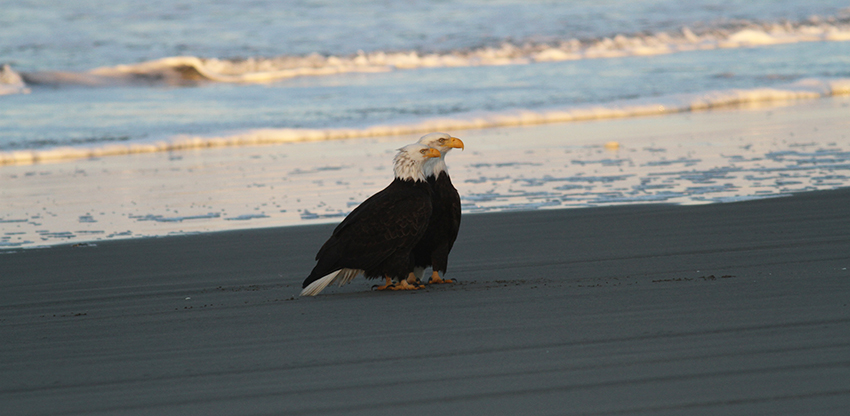
Eagle pairs seem to make lifelong bonds; they cooperate in hunting and in defending their territory. They stake out territory for feeding “but they defend a little larger piece of the world when they’re nesting and raising juveniles,” Neal says.
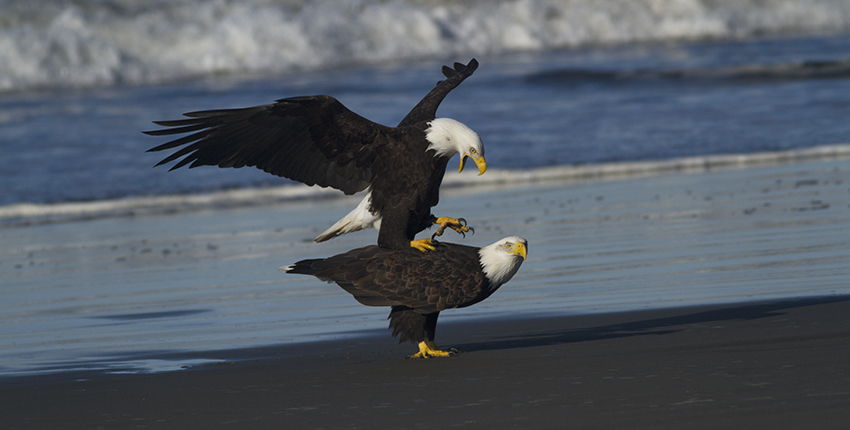
Aerial acrobatics can be part of courtship—dramatic displays that may involve locking talons in midair. Actual copulation takes place on solid ground.
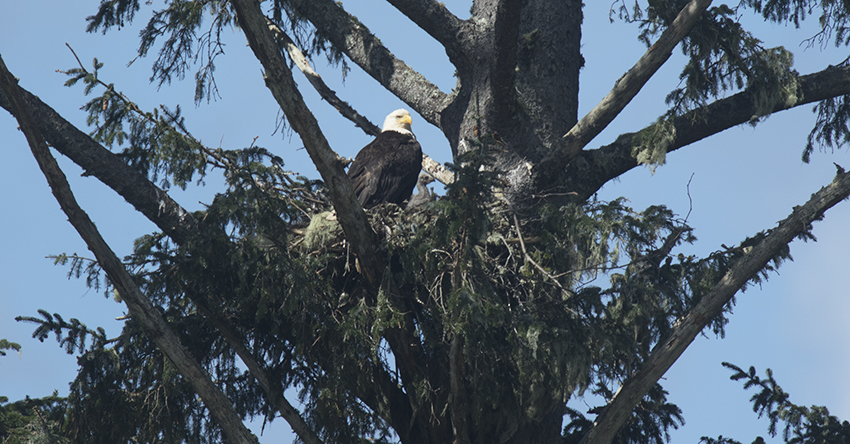
See that little gray eaglet? Neal shot this during the spring 2017 nesting season. This nest is on private land adjacent to the Conservancy’s property at Stanley Lake, which is part of this pair’s territory. The lake helps provide the roughly 300 pounds of organic material—fish, carrion, or other food sources—required to raise an eaglet to the point of fledging. That’s a lot of hunting. Early after eaglets are born, the male does nearly all the hunting; later the female or even both parents will leave the nest to hunt.
Eagle nests are huge—they may weigh 1 ton, or even more—and are used year after year after a little remodeling. This eagle and its mate used to nest next to the Seaside Airport but relocated to this site three years ago.

Now you see the same eaglet and its sibling just a few weeks later, no longer gray but dark brown. They’re nearly as large as their parents, but they’re still being fed bite-sized bits of food by a parent. Note that the two adolescents aren’t fighting over the food, but one eagle is waiting its turn while the other feeds. If the second eaglet looks like it’s cowering, it may well be, Neal says. “There’s a kind of hierarchy,” Neal explains, “so if the food supply doesn’t show up, somebody survives and the other one fades.” One eaglet might have hatched earlier, or might have been a bit more aggressive. For whatever reason, it’s a survival mechanism that seems to work for the species.

Within weeks of hatching, the chicks have fledged. This juvenile eagle’s coloring indicates that it’s two or three years old. Spotting an eagle like this one, standing on a dead sea lion, can be a dramatic moment for beachgoers. But Neal urges us to remember that the eagle isn’t just there for that moment. “They’re living here every minute, 24/7, 365 days a year, living life and seeking food and battling for territory.”
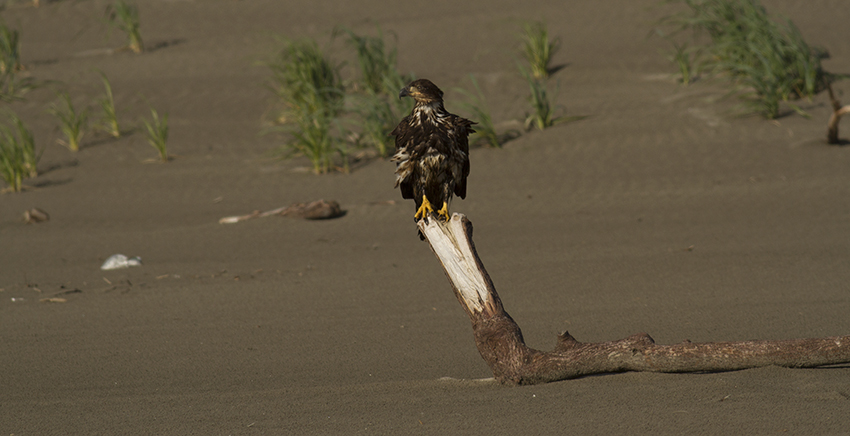
Take this juvenile, perched on a piece of driftwood on the beach, the wind ruffling its feathers. It seems to be just chilling, taking the day off. “This is a good example of ‘There’s nothing going on,'” Neal says, “but there’s never nothing going on.” Even in rest, eagles are always alert to opportunity. “Because of their eyesight, if a gull went after something on the beach a half-mile away, that eagle would watch it happening and take off and attempt to take it away,” Neal says. “Their optical scan is so huge that any little tip-off—a gull gliding down to the beach, a gull landing in the water just outside the waves, a seabird floundering offshore—can be a clue, and they’re off. I just watch them and follow them. It’s incredible, how they can they see a piece of a crab a half-mile away.” Gulls provide lots of clues to eagles for where to find food. “They depend on stealing food maybe half the time.”
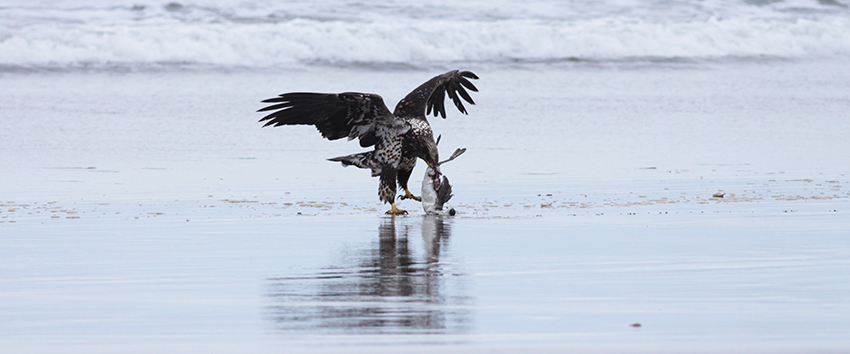
“That thin strip of coastline is better looked at holistically as one habitat rather than as separate ecosystems—ocean, beach, dunes, wetland, coastal forest,” Neal says. “They look like separate places, but they’re all so interconnected. You can’t just save the beaches. You can’t just save wetlands. At the coast, the eagles teach us to look at the coastal landscape, the coastline, as one unique, interactive ecosystem. The eagles represent that, because they use those habitats as one connected system.”
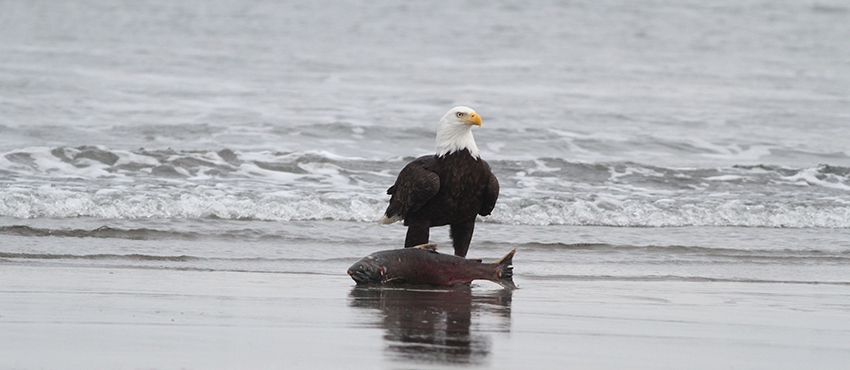
This eagle caught this adult Chinook salmon in the surfline (it’s the same fish and bird as in the top photo). “It had been in the open ocean or four years and was headed to a freshwater stream to spawn,” Neal says. “Eagles are working the surf, they’re working the streams, they’re working that whole system.”
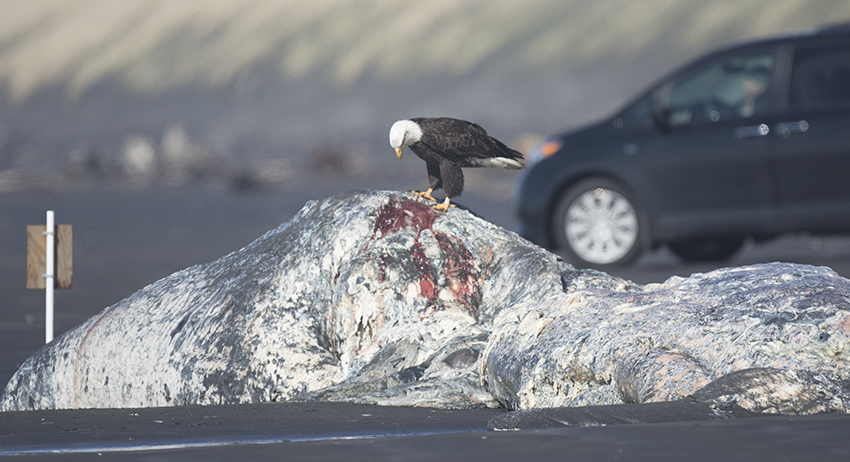
Bald eagles perform an important function of feeding on carcasses, such as on this decomposing sperm whale that washed up on the beach just north of the Peter Iredale shipwreck in March 2017. “That whale became a daily routine for the eagles,” says Neal, who was there every day for weeks, watching them. “A good portion of their food is carrion. Because there’s so much drift material on the beach, they almost become addicted to beachcombing.”

Likewise this sea lion carcass. One day Neal spotted no less than 21 bald eagles on or near this carcass, 14 of them juveniles. “For juveniles during the winter, the beach is where the action is,” Neal says. Whatever or whoever caused this sea lion’s death, juvenile eagles did their best to lay claim to it. Again, notice the hierarchy: Two juveniles going talon-to-talon to claim it, while a sub-adult stands on the carcass and two more juveniles stand just a little farther away, waiting their turn. Females are 15 to 20 percent larger than males, “so they have a lot of takeover power on these carcasses.” Neal says. “Meanwhile the crows know exactly what the eagles’ potential peck-reach is, and they sneak in. They’re worth watching on their own, because they’re psyching the whole thing out. There seems to be a point sometimes where the crows negotiate a deal with the eagles and a crow gets in and gets a bite, even though it’s within an eagle’s reach.
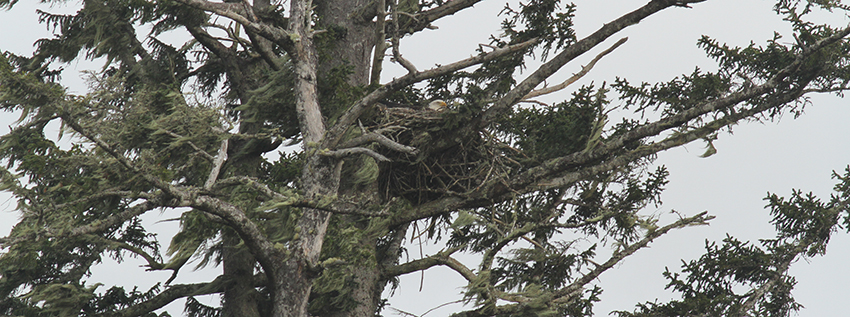
This nest is in the Gearhart Fen, adjacent to the 522 acres of fen that the Conservancy protects. Neal shot this photo just a couple of weeks ago. Neal has been checking in on this nest frequently, observing the female on the nest, probably incubating a couple of eggs. Bald eagles hatch after 34 or 35 days of incubation. We’ll let you know what happens in next month’s enews.
Comments